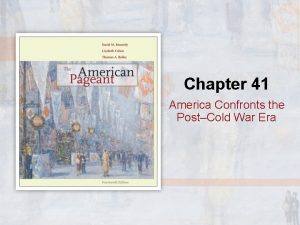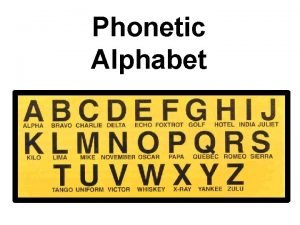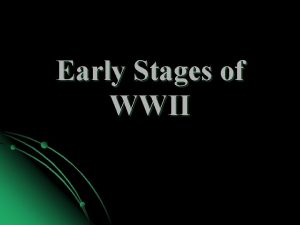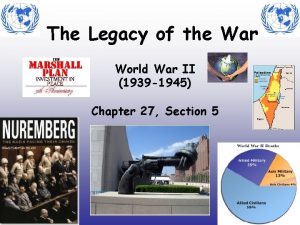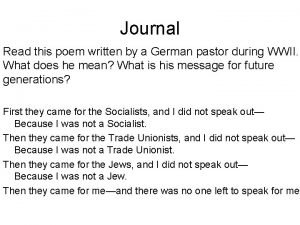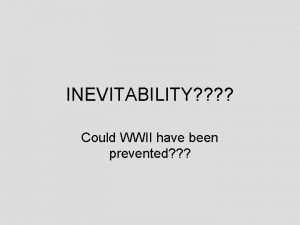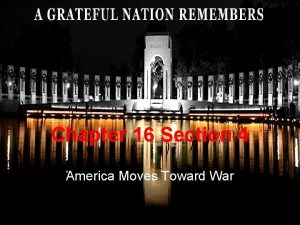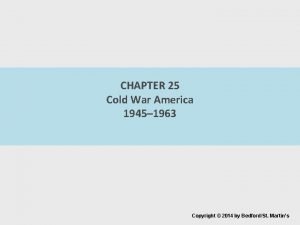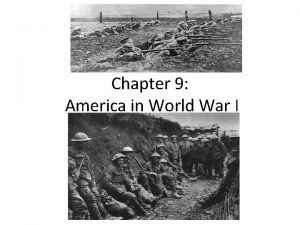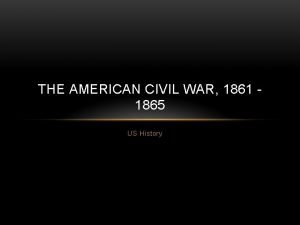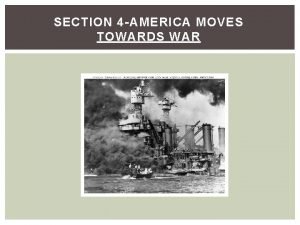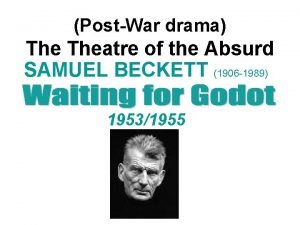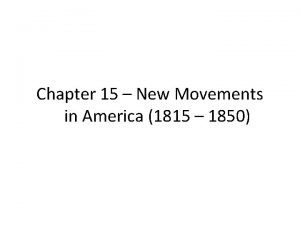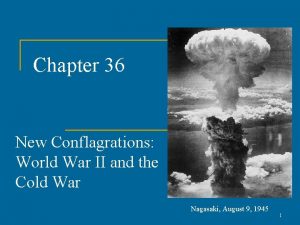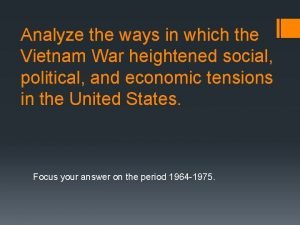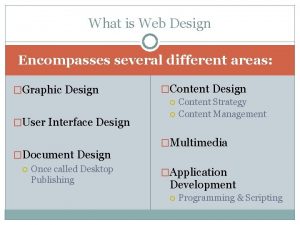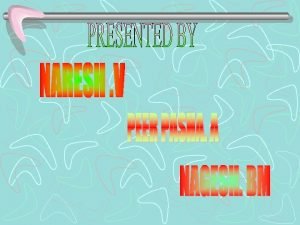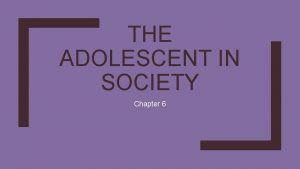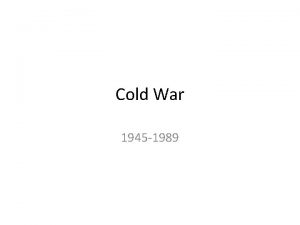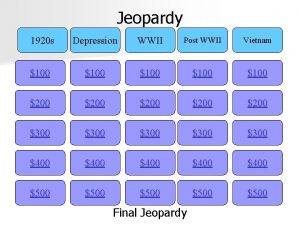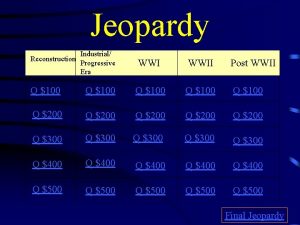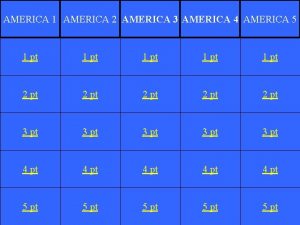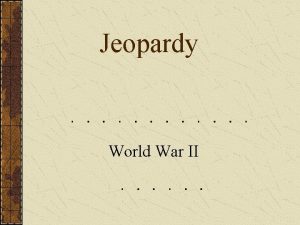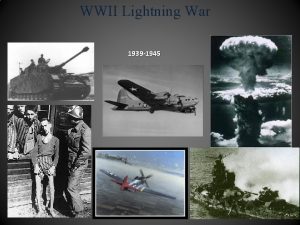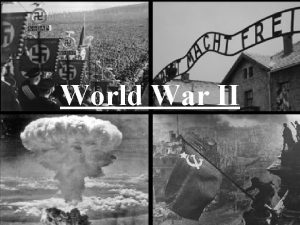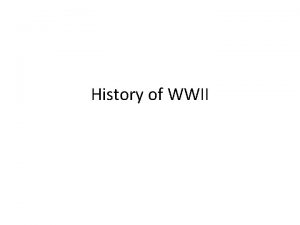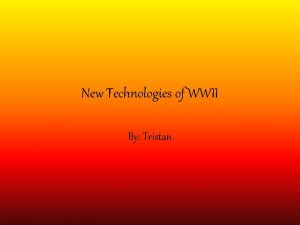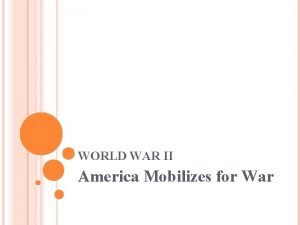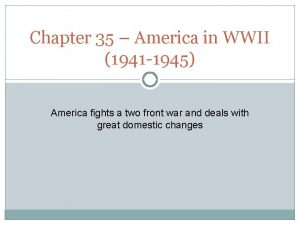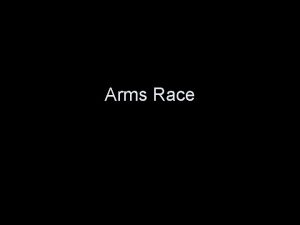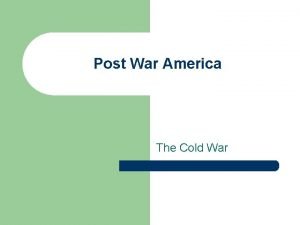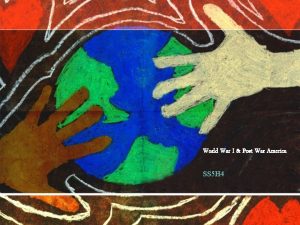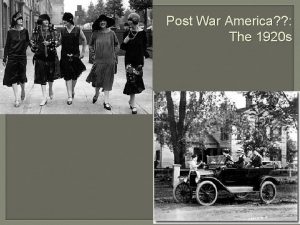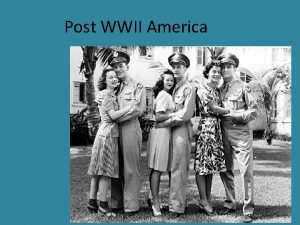Post War America Post WWII Several new social
























































- Slides: 56

Post War America

Post WWII Several new social issues emerge… 1. Baby Boom 2. Housing Crisis 3. Economic Readjustment

1. Baby Boom - People born between 1945 and 1960 -Why did this happen? Causes - Return of Soldiers - End of Depression Effects - Population Increase - Lack of housing


- Causes 2. Housing Crisis - Return of Soldiers - Overcrowding cities - Baby boomers - Solution: - Suburbanization - Who is left in cities?

2. Housing Crisis Levittown's - Cheap housing - 4 towns in U. S. - Houses based on a few basic models - A house could be built in one day using assembly line process - Residents limited to the “Caucasian Race”



Housing Crisis Levittown, Long Island: “The American Dream”

3. Economic Readjustment - Causes: – Wartime to Peacetime Economy – Return of Soldiers – Office of Price Admin eases regulation Impact - Unemployment - 5%+ - Inflation - Wages cant keep up - Strikes * Not as bad as post WWI



Anti – Union Movement • Why? – 2 nd Red Scare – Increase in strikes

• Labor Unrest – United Mine Workers (John Lewis) • 40 day strike in 1943 • Truman orders govt seizure of mines – Employers meet many of the demands – The Rail Strike of 1946 • First ever complete shut down • Strike ended 3 minutes before Truman orders army to seize railroads and to draft strikers • Taft Hartley Act 1947 – a. k. a. “Slave Labor Bill” – Allows states to become “right to work” states • Truman Vetoes -> Veto overridden



Truman’s Domestic Policy Fair Deal: - Extension of New Deal Wanted… • Full Employment • Raise Minimum Wage – 40 cents to 65 cents • Create Public Housing • Universal Healthcare • Nationalize Atomic Energy • Extend Social Security • Aid to Education • Aid to Scientific Research

Fair Deal Rejected • Growing Conservative movement kills most of the plan • “Had Enough” midterm election • Alienates Southern Dems with proposal of Civil Rights Laws • Truman's popularity dropping quickly

Election of 1948 Harry Truman Democrat Strom Thurmond “Dixiecrat” George Dewey Republican

• 1948 Election - Democrats (Truman) re-elected - Dixiecrats (Strom Thurmond) - Republican (Thomas Dewey)



Fair Deal Revised • Minimum Raise – Increased to 75 cents • Social Security – Extended and Expanded • National Housing Act of 1949 – Provided 800, 000 units of low income housing • Civil Rights – Integrated Military (1948) – Most Civil Rights laws Filibustered by Republicans and Dixiecrats

2 nd Term - Truman’s approval rate goes down - 1949 - “Loss” of China to Communism - 1950 - Korean War - 1951 - Firing of Douglas Mac. Arthur

Election of 1952 Dwight D. Eisenhower Adlai Stevenson


Election of 1952 • • First Republican win since 1928

Eisenhower’s (Ike) Presidency War Hero Moderate Domestic Policy Coined the phrase “Modern Republicanism”

Modern Republicanism • “Old Guard” Republicans – Wanted to dismantle New Deal & Fair Deal • “Modern Republicans” – Wanted Balanced Budget But…. – Released New Deal and Fair Deal programs were the new normal

“Modern Republicanism” What he did… – Expanded Social Security (+10 Mil) – Raised Minimum Wage ($1) – Expanded Housing – Supported right to Unionize – Supported Public Works Projects (Interstates) – Created the Dept of Health, Education, and Welfare How did we pay for this? – Did not lower taxes despite end of war.


Science Increasing focus on scientific discoveries/innovations

Progress Through Science 1951 -- First IBM Mainframe Computer 1952 -- Hydrogen Bomb Test 1953 -- DNA Structure Discovered 1954 -- Salk Vaccine Tested for Polio 1957 -- First Commercial U. S. Nuclear Power Plant 1958 -- NASA Created 1959 -- Press Conference of the First 7 American Astronauts

Progress Through Science 1957 Russians launch SPUTNIK I Impact – • National Defense Education Act of 1958 • Creation of NASA • Beginning of the Space Race

Progress Through Science UFO Sightings skyrocketed in the 1950 s. War of the Worlds

Progress Through Science Atomic Anxieties: “Duck-and-Cover Generation” Atomic Testing: 1946 -1962 U. S. exploded hundreds of nuclear weapons over the Pacific and in Nevada.

Consumerism: – The buying of material goods = success – $145 million on lawn/patio furniture Impact: - Rise of Credit - Diner’s Club –first credit card (1950) - American Express (1958) - Advertising - Television becomes a powerful tool

Consumerism 1950 Introduction of the Diner’s Card All babies were potential consumers who spearheaded a brand-new market for food, clothing, and shelter. -- Life Magazine (May, 1958)

Suburban Lifestyle 1. Conglomerates: major corporation that has smaller unrelated industries. 2. Franchises: Company in different locations First Mc. Donald’s (1955 - Ill. ) Drive-In Movies Howard Johnson’s

Suburban Lifestyle The U. S. population was on the move in the 1950 s. NE & Mid-W S & SW (“Sunbelt” states) 1955 Disneyland opened in Southern California. (40% of the guests came from outside California, most by car. ) Frontier Land Main Street Tomorrow Land

Suburban Lifestyle Car registrations: 1945 25, 000 1960 60, 000 2 -family cars doubles from 1951 -1958 Pink Cadillac 1959 Chevy Corvette 1956 Interstate Highway Act largest public works project in American history! Created by Dwight D. Eisenhower Cost $32 billion. 41, 000 miles of new highways built.

• A Changing Workplace Automation: • 1947 -1957 factory workers decreased by 4. 3% • 1. 5 million blue-collar jobs eliminated • By 1956 more white-collar than blue-collar jobs. • Computers Mark I (1944). First IBM mainframe computer (1951).

Mass Media 1939 - Television available to general public 1946 7, 000 TV sets in the U. S. 1950 50, 000 TV sets in the U. S. Truth, Justice, and the American way!

Mass Media Davy Crockett King of the Wild Frontier Sheriff Matt Dillon, Gunsmoke The Lone Ranger (and his faithful sidekick, Tonto): Who is that masked man? ?

Mass Media Children’s Programming Mickey Mouse Club Howdy Doody

Mass Media Glossy view of mostly middle-class suburban life. But. . . I Love Lucy Social Winners? . . . AND… The Honeymooners Loosers?

Teen Culture Behavioral Rules of the 1950 s: Obeyed Authority. Control Your Emotions. Don’t Make Waves Fit in with the Group. Pleasantville

Teen Culture In the 1950 s the word “teenager” entered the American language. By 1956 13 mil. teens with $7 bil. to spend a year. 1951 Alan Freed (Cleveland, Ohio) “ROCK ‘N ROLL” Elvis Presley “The King”

Teen Culture “Juvenile Delinquency” ? ? ? 1951 J. D. Salinger’s A Catcher in the Rye Marlon Brando in The Wild One (1953) James Dean in Rebel Without a Cause (1955)

Teen Culture The “Beat” Generation: à Anti-Conformists Central elements of "Beat" culture included rejection of received standards, innovations in style, experimentation with drugs, alternative sexualities, an interest in Eastern religion, a rejection of materialism, and explicit portrayals of the human condition “Beatnik” “Clean ” Teen


Religious Revival Today in the U. S. , the Christian faith is back in the center of things. -- Time magazine, 1954 Church membership: 1940 64, 000 1960 114, 000 Television Preachers: 1. Catholic Bishop Fulton J. Sheen “Life is Worth Living” 2. Methodist Minister Norman Vincent Peale The Power of Positive Thinking 3. Reverend Billy Graham ecumenical message; warned against the evils of Communism.

Religious Revival Hollywood: apex of the biblical epics. The Robe 1953 The Ten Commandments Ben Hur 1956 1959 It’s un-American to be un-religious! -- The Christian Century, 1954

• Well-Defined Gender Roles The ideal modern woman married, cooked and cared for her family, and kept herself busy by joining the local PTA and leading a troop of Campfire Girls. She entertained guests in her family’s suburban house and worked out on the trampoline to keep her size 12 figure. --Life magazine, 1956 Marilyn Monroe The ideal 1950 s man was the provider, protector, and the boss of the house. -- Life magazine, 1955 1956 William H. Whyte, Jr. The Organization Man a middle-class, white suburban male is the ideal.

The Other America • A Large percentage of American’s do not experience prosperity of the 50’s - Urban Poor - White flight: middle class America leaves cities for suburbs - African Americans - 1945 -1960: 5 million move from rural South to urban areas

The Inner Cities
 America confronts the post-cold war era
America confronts the post-cold war era Phonetic alphabet letters
Phonetic alphabet letters Advances in technology during wwii
Advances in technology during wwii Nye committee hearings
Nye committee hearings Wwii picture
Wwii picture Wwii picture
Wwii picture Wwii study guide
Wwii study guide Effects of ww2
Effects of ww2 Color tv started
Color tv started 1500 dead in hawaii congress votes war
1500 dead in hawaii congress votes war Causes of wwii
Causes of wwii Map of german aggression wwii
Map of german aggression wwii Wwii
Wwii Could wwii have been prevented
Could wwii have been prevented Wwii test review
Wwii test review Zoot suit riots apush
Zoot suit riots apush Rap of the states
Rap of the states Asia africa north and south america
Asia africa north and south america Whats an onomatopeia
Whats an onomatopeia Why is latin america called latin america
Why is latin america called latin america Performance e body art
Performance e body art Atlantic charter
Atlantic charter Chapter 24 section 4 america moves toward war
Chapter 24 section 4 america moves toward war Chapter 25 cold war america
Chapter 25 cold war america Chapter 9 america in world war 1
Chapter 9 america in world war 1 America civil war
America civil war America moves toward war section 4
America moves toward war section 4 Apa itu social thinking
Apa itu social thinking Social thinking social influence social relations
Social thinking social influence social relations War at home vs war abroad madison
War at home vs war abroad madison Korean war vietnam war venn diagram
Korean war vietnam war venn diagram Lesson 1 the origins of the cold war
Lesson 1 the origins of the cold war Presidential and radical reconstruction venn diagram
Presidential and radical reconstruction venn diagram Was john bradford pro war or anti war
Was john bradford pro war or anti war Ich bin du bist remse
Ich bin du bist remse Balanced force
Balanced force Civil war first modern war
Civil war first modern war Bringen pasado simple
Bringen pasado simple Toward civil war lesson 3 secession and war
Toward civil war lesson 3 secession and war Sides in cold war
Sides in cold war Chapter 30 the war to end war
Chapter 30 the war to end war Chapter 30 the war to end war
Chapter 30 the war to end war Post war drama
Post war drama Time magazine the new face of america
Time magazine the new face of america New movements in america
New movements in america New movements in america section 1
New movements in america section 1 Social class pyramid of latin america
Social class pyramid of latin america Chapter 37 new conflagrations world war ii
Chapter 37 new conflagrations world war ii New conflagrations world war ii
New conflagrations world war ii Analyze the ways in which the vietnam war heightened social
Analyze the ways in which the vietnam war heightened social It encompasses several different aspects, including
It encompasses several different aspects, including What is the mixture of several gases
What is the mixture of several gases Challenges of adolescence
Challenges of adolescence A consumer confidence researcher asks several retailers
A consumer confidence researcher asks several retailers Balancing of several masses rotating in the same plane
Balancing of several masses rotating in the same plane Count nouns and quantifiers
Count nouns and quantifiers Dating serves several important functions that include:
Dating serves several important functions that include:
